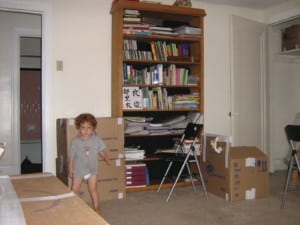 Six years ago, I self-diagnosed myself with Reverse Culture Shock, or RCS, an emotional displacement syndrome. I know this because, after 7 years of doing reverse immigration to the States in 2007, I stumbled upon the symptoms of Reverse Culture Shock on an archived U.S. State Department’s home page. Suddenly, I felt recognized and validated in a country that didn’t exactly welcome me back with open arms when we left Israel in 2007.
Six years ago, I self-diagnosed myself with Reverse Culture Shock, or RCS, an emotional displacement syndrome. I know this because, after 7 years of doing reverse immigration to the States in 2007, I stumbled upon the symptoms of Reverse Culture Shock on an archived U.S. State Department’s home page. Suddenly, I felt recognized and validated in a country that didn’t exactly welcome me back with open arms when we left Israel in 2007.
“While the phenomenon of culture shock is increasingly well known (and relatively well prepared for in the foreign affairs community), Reverse Culture Shock is not as recognized and understood. This is due in part to the fact that people are returning home. So why should “returning home” result in culture shock?”
This answers the question, “what is Reverse Culture Shock?” and for me personally, it also answers the question of why I had to write an expat memoir called Sand and Steel that investigated this exact question.
I’ve expended a lot of energy figuring out how to cope with Reverse Culture Shock which impacted my ability to live a culturally fulfilling life in the States. Making a new life in a new country brings up all kinds of conflicting emotions. And yet I still long for the kind of home I left. So, without further ado, here are the top 5 things I wish people would understand about Reverse Culture Shock and those like myself who live with it.
 1.Reverse Culture Shock is experienced subjectively and individually. Each person has a unique experience adapting and readapting to the home culture. A lot depends on a person’s ability to feel at home quickly – flexibility, adaptability, the “sand and steel” mindset I write about in my memoir. A lot also has to do with one’s personal circumstances and upbringing.
1.Reverse Culture Shock is experienced subjectively and individually. Each person has a unique experience adapting and readapting to the home culture. A lot depends on a person’s ability to feel at home quickly – flexibility, adaptability, the “sand and steel” mindset I write about in my memoir. A lot also has to do with one’s personal circumstances and upbringing.
There have been moments when the longing for Israel is so intense, I feel like I’ve been run over. It’s like I’m trapped in newness. I have to remember to slow down, do more personal outreach, connect. This takes a lot of inner strength and compassion. In Israel, people are naturally wired for this connection. But America’s far-flung geographic distances create an aversion, a distraction. A feeling of homelessness.
2. Reverse Culture Shock can get triggered. While it took years to find roots in Pittsburgh, there are days when my Reverse Culture Shock gets triggered. I think it has to do with the fact that I live in a tight-knit insular Jewish community where families have each other. On Jewish holidays, in particular, I feel the loss of not being able to celebrate with our own family and friends particularly since the Israeli culture is like one big family. Life in Israel vs USA.
3. There are still expectations to feel more at home. Like grief and mourning of a loved one, there are stages of Reverse Culture Shock. The loss of a home, learning to reconcile those feelings, learning to let go. Just this past Shabbat as I walking through Schenley Park taking in the foliage and the unusually hot summery day, I felt an intense pang of loneliness. Even with the bikers and joggers, the park was strangely too quiet. Then I realized: There was no-one to share my excitement. I was looking to share my observations in a particular way with a good friend and colleague back home in Israel where I’d be able to get to the gist quickly of what I was feeling and observing. Unfortunately, I haven’t been able to do that regularly in America and it bothers me. A lot.
 4. Reverse Culture Shock isn’t just a cultural thing. It is experienced psychologically, emotionally, and culturally and most times, these feelings can be fused into one. There were many Rosh Hashanas for example when I’d entered our synagogue and see congregants celebrating with their families. Immediately I’d tear up and remember what we’d given up to come to America. I’d often feel left out of an experience because I didn’t have our family and friends to get together not just on the Jewish holidays but on Friday afternoons.
4. Reverse Culture Shock isn’t just a cultural thing. It is experienced psychologically, emotionally, and culturally and most times, these feelings can be fused into one. There were many Rosh Hashanas for example when I’d entered our synagogue and see congregants celebrating with their families. Immediately I’d tear up and remember what we’d given up to come to America. I’d often feel left out of an experience because I didn’t have our family and friends to get together not just on the Jewish holidays but on Friday afternoons.
5. Experiencing Reverse Culture Shock all over again after many years feels like waiting for a loved one to change. There have been days, years, and months of breeding familiarity. I’ve gotten accustomed to the cracks in my ceiling, my quiet tree-lined street, the hour of the day when the neon orange street lights appear. I know who I can count on for help. I know where, on our street, the cell reception gets weaker. I know at what point in the year, the seasons start getting more brittle grey than gold and yellow. I can count the number of neighbors I’ve gotten to know over the years. I know how many times during the year, the neighbor next door appears on her back porch since we bought our home in 2015. Zero.
But there are moments in the Reverse Culture Shock cycle when all this familiarity doesn’t feel familiar anymore. I keep asking myself, “Do you come back home or stay in America?”
Part of me still wants to return to Israel because my heart craves the connections that made me feel at home as a young IDF soldier, English teacher, wife. On the flight back to the United States in 2018 after celebrating our son’s Bar-Mitzvah at the Western Wall in Jerusalem, I Facebooked, “someone help me please because I do not want to get on that plane.” In the same way, I knew what I was given up in 2007 when we left, I knew exactly what I was leaving and what I was coming back to. Life in Israel vs USA. To this day, I wish economics didn’t have to be the sole reason for leaving a country we both loved but we had to save our family.
Are you an expat? Do you struggle at times with Reverse Culture Shock? How do you cope?
 To pre-order your copy of Sand and Steel: A Memoir of Longing and Finding Home, click here.
To pre-order your copy of Sand and Steel: A Memoir of Longing and Finding Home, click here.
Every pre-order will receive a free copy of my award-winning memoir Accidental Soldier: A Memoir of Service and Sacrifice in the Israel Defense Forces. To get your free copy, just email your pre-order receipt to: sassondorit@gmail.com or click here.




Connect with Dorit